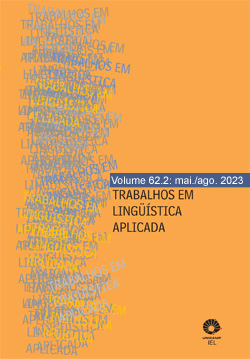Abstract
Teaching Portuguese as an Additional Language in an academic context requires contemplating uses of this language in oral and written productions that involve different degrees of abstraction and semantic complexity. These practices are interconnected by two aspects: by the way in which practical, horizontal and everyday knowledge prevails in high school and theoretical, vertical, and abstract knowledge in higher education; and also because it is an additional language. These challenges lie in the semantic dimension that conceives these practices as semantic waves whose organizing principles comprise semantic gravity (SG) and semantic density (SD) (MATON, 2013; 2020). The aim of this study is to discuss how semantic waves can be evidenced in a Portuguese as an Additional Language course organized into topics, offered to first-year undergraduate students at a British university. The analysis focuses on samples of the teaching materials and some tasks completed by learners to demonstrate how knowledge initially characterized by strong semantic density is “unpacked” (MATON, 2020) through different examples and practical uses. The contribution concerns the benefit of taking semantic waves into account when planning an additional language course, since most studies focus on other areas of knowledge, but little on the teaching of languages, especially Portuguese as an Additional Language.
References
ALZU’BI, M. A. (2019). The influence of suggested Cornell note-taking method on improving writing composition skills of Jordanian EFL learners. Journal of Language Teaching and Research, v. 10, n. 4, p. 863-871. http://dx.doi.org/10.17507/jltr.1004.26
BERNSTEIN, B. (1971). Class, codes and control: Theoretical studies towards a sociology of language, v. 1. London: Routledge and Kegan Paul.
BERNSTEIN, B. (1975). Class, codes and control: Towards a theory of educational transmissions, v. 3. London: Routledge and Kegan Paul.
BERNSTEIN, B. (1990). Class, codes and control: The structuring of pedagogic discourse, v. 4. London: Routledge.
BERNSTEIN, B. (2000). Pedagogy, symbolic control and identity: Theory, research, critique 2ª ed. Oxford: Rowman & Littlefield.
BOCHECO, O. (2021). A abordagem matemática no ensino de física e sua qualificação no viés semântico. Tese de doutorado. Programa de Pós-Graduação em Educação Científica e Tecnológica, UFSC, Florianópolis.
CLARENCE, S. (2016). Exploring the nature of disciplinary teaching and learning using Legitimation Code Theory Semantics. Teaching in Higher Education, v. 21, n. 2, p. 123-137. https://doi.org/10.1080/13562517.2015.1115972
CRANWELL, P. B.; WHITESIDE, K. L. (2020). Investigation into the semantic density and semantic gravity wave profile of teachers when discussing electrophilic aromatic substitution (SEAr). Journal of Chemical Education, v. 97, n. 10, p. 3540-3550. https://dx.doi.org/10.1021/acs.jchemed.0c00571
CURZON, P.; WAITE, J.; MATON, K.; DONOHUE, J. (2020). Using semantic waves to analyse the effectiveness of unplugged computing activities. In: WiPSCE “20: Proceedings of the 15th Workshop on Primary and Secondary Computing Education, p. 1-10. https://doi.org/10.1145/3421590.3421606
Da SILVA, A. M. (2010). Ensino de Português Língua Estrangeira (PLE) por meio de filme: considerações sobre o Portfólio Europeu para Línguas (CEFLs). Revista Littera, 1 (1), 121-133.
De ANGELIS, G. 2007. Third or additional language acquisition. Second Language Acquisition. 24. Multilingual Matters Ltd.
DONOHOO, J. (2010). Learning how to learn: Cornell notes as an example. Journal of Adolescent & Adult Literacy, v. 54, p. 224-227. https://doi.org/10.1598/JAAL.54.3.9
DÖRNYEI, Z. (2007). Research methods in Applied Linguistics. New York: Oxford University Press.
MACNAUGHT, L.; MATON, K.; MARTIN, J. R.; MATRUGLIO, E. (2013). Jointly constructing semantic waves: implications for teacher training. Linguistics and Education, v. 24, p. 50-63. https://doi.org/10.1016/j.linged.2012.11.008
MATON, K. (2013). Making semantic waves: A key to cumulative knowledge-building. Linguistics and Education, v. 24, p. 8-22. https://doi.org/10.1016/j.linged.2012.11.005
MATON, K. (2020). Semantic waves: Context, complexity, and academic discourse. In: MARTIN, J.; MATON, K.; DORAN, Y. J. (org.), Accessing academic discourse: Systemic Functional Linguistics and Legitimation Code Theory. London: Routledge, p. 59-85.
MATON, K.; HOWARD, S. K. (2020). Autonomy: the next phase of dialogue between systemic functional linguistics and Legitimation Code Theory. Journal of World Languages, v. 6, n. 1-2, p. 92-112. https://doi.org/10.1080/21698252.2020.1720160
MATRUGLIO, E.; MATON, K.; MARTIN, J. R. (2013). Time travel: The role of temporality in enabling semantic waves in secondary school teaching. Linguistics and Education, v. 24, p. 38-49. https://doi.org/10.1016/j.linged.2012.11.007
MOUTON, M. (2020). A case for project based learning to enact semantic waves: towards cumulative knowledge building. Journal of Biological Education, v. 54, n. 4, p. 363-380, https://doi.org/10.1080/00219266.2019.1585379
PINTO, B. C. N.; WARTHA, E. J. (2021). Dimensão semântica na sala de aula de Ciências: rodas de conversa como promotor de ondas semânticas. Investigações em Ensino de Ciências, v. 26, n. 3, p. 220-236. https://doi.org/10.22600/1518-8795.ienci2021v26n3p220
PIRES, C. Z. (2022). Leitura compartilhada e leitura crítica: a construção do conhecimento em contexto escolar orientada pela pedagogia com base em gêneros da escola de Sydney. Tese de doutorado. Programa de Pós-Graduação em Letras da UFRGS, Porto Alegre.
ROTTAVA, L. (2009). Português como língua terceira (L3) ou língua estrangeira (LE) adicional: a voz do aprendiz indicando identidade. Em Aberto, Brasília, v. 22, n. 81, p. 81-98.
ROTTAVA, L.; Da SILVA, A. M. (2013). Influência interlinguística no processo de escrita em português LE-adicional. In: K. A. da Silva; D. T. dos Santos (org.). Português como língua (inter)nacional: faces e interfaces. Campinas, SP: Pontes Editores, p. 275-297.
SANTOS, B. F. dos; MOTIMER, E. F. (2019). Ondas semânticas e a dimensão epistêmica do discurso na sala de aula de Química. Investigações em Ensino de Ciências, v. 24, n. 1, p. 62-80. https://doi.org/10.22600/1518-8795.ienci2019v24n1p62
STREET, B. (2003). What’s new in new literacy studies? Critical approaches to literacy in theory and practice. Current Issues in Comparative Education, v. 5, n. 2. Disponível em: https://www.tc.columbia.edu/cice/pdf/25734_5_2_Street.pdf. Acessado em maio de 2023.
VYGOTSKY, L. (1984). A formação social da mente. São Paulo: Martins Fontes.

This work is licensed under a Creative Commons Attribution 4.0 International License.
Copyright (c) 2023 Trabalhos em Linguística Aplicada


